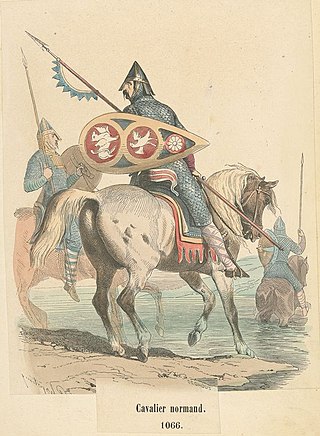Year 1020 (MXX) was a leap year starting on Friday of the Julian calendar.

The Catepanateof Italy was a province of the Byzantine Empire from 965 until 1071. At its greatest extent, it comprised mainland Italy south of a line drawn from Monte Gargano to the Gulf of Salerno. North of that line, Amalfi and Naples also maintained allegiance to Constantinople through the catepan. The Italian region of Capitanata derives its name from katepanikion.
Argyrus was a Lombard nobleman and Byzantine general, son of the Lombard hero Melus. He was born in Bari.
Eustathius or Eustathios is a Greek masculine given name, in English rendered Eustace. It may refer to:
Michael Dokeianos, erroneously called Doukeianos by some modern writers, was a Byzantine nobleman and military leader, who married into the Komnenos family. He was active in Sicily under George Maniakes before going to Southern Italy as Catepan of Italy in 1040–41. He was recalled after being twice defeated in battle during the Lombard-Norman revolt of 1041, a decisive moment in the eventual Norman conquest of southern Italy. He is next recorded in 1050, fighting against a Pecheneg raid in Thrace. He was captured during battle but managed to maim the Pecheneg leader, after which he was put to death and mutilated.
The Battle of Cannae took place in 1018 between the Byzantines under the Catepan of Italy Basil Boioannes and the Lombards under Melus of Bari. The Lombards had also hired some Norman cavalry mercenaries under their leader Gilbert Buatère, while Boioannes had a detachment of elite Varangian Guard sent to him at his request to combat the Normans. The engagement was one of the first clashes between the Byzantines of southern Italy and the Normans.

Byzantius was the archbishop of Bari in the early eleventh century. He began the construction of the new cathedral, which was continued by his successors.
John Kourkouas or Curcuas was the Byzantine catepan of Italy from 1008 to 1010.
Pardos was the catepan of Italy briefly in 1042 following the short term of George Maniakes.
Christopher or Christophoros Burgaris was the short-tenured successor of the famous Basil Boioannes as catepan of Italy.

Pothos Argyros or Argyrus was a Byzantine commander, who served as the catepan of Italy during the eventful years of 1029 to 1031.
Dattus was a Lombard leader from Bari, the brother-in-law of Melus of Bari. He joined his brother-in-law in a 1009 revolt against Byzantine authority in southern Italy.
Michael Protospatharios was the Byzantine catepan of Italy from 1031 to 1033. He was sent to Bari after his predecessor, Pothos Argyrus, was killed in battle with the Saracens who took Cassano allo Ionio in Calabria. Michael was high and lofty official in the imperial court of Constantinople. He held several high-ranking titles. At the height of his career, his full title was: ἐπὶ τῶν οἰκιακῶν, κατεπάνω Ἰταλίας, κριτὴς τοῦ βήλου καί τοῦ ἱπποδρόμου, that is, "Chamberlain, catepan of Italy, and kritēs of the vēlon and the Hippodrome". The kritēs was probably an officer in charge of processing requests for the audience of the emperor. Michael arrived in Italy early in 1032 with a new army, composed not only of recruits from the West or the auxiliaries, but also from the elite troops of Asia Minor and Syria. It is unknown what became of this grand army, however, as Michael was replaced in 1033 by Constantinos Opos.
Basil III Theodorokanos or Theodorocanus was the Byzantine Catepan of Italy from February to the Spring of 1043. He was a patrician and a former companion in arms of George Maniakes when he was appointed to go to Apulia and Calabria and put down the revolts of Maniakes and of Argyrus in 1042. In February 1043, he landed at Bari. Argyrus and his Normans tried to surround Otranto, but the catepan's fleet blocked them. Maniakes, however, debarked for Dyrrhachium with his army. Argyrus eventually made peace with the Greeks and Theodorokanos was replaced by Eustathios Palatinos. Subsequently, he commanded the Byzantine fleet against the Rus' raid in July 1043.
John Raphael or Rafayl was the catepan of Italy from September to December 1046 AD. He replaced the catepan Eustathios Palatinos and arrived with an army of Varangian auxiliaries in Bari.
Marules was the Byzantine catepan of Italy in 1060/1061. Appointed by the Emperor Constantine X, he arrived in Bari between 1 September 1060 and 31 August 1061, according to the Anonymous Chronicle of Bari. He was the first catepan appointed after Argyros left Italy in 1058. He had been preceded in 1060 by a merarches, but the latter's offensive against the Normans had peaked before his arrival and he adopted a defensive posture.
The siege of Bari took place 1068–71, during the Middle Ages, when Norman forces, under the command of Robert Guiscard, laid siege to the city of Bari, a major stronghold of the Byzantines in Italy and the capital of the Catepanate of Italy, starting from 5 August 1068. Bari was captured on 16 April 1071 when Robert Guiscard entered the city, ending over five centuries of Byzantine presence in Southern Italy.

The Battle of Olivento was fought on 17 March 1041 between the Byzantine Empire and the Normans of southern Italy and their Lombard allies near the Olivento river, between the actual Basilicata and Apulia, southern Italy.
Abulchares was a Byzantine general of Arab origin who served as the catepan of Italy from 1064 until his death. The chief sources for his catapanate are Skylitzes Continuatus and Anonymi Barensis Chronicon. Skylitzes Continuatus records that Abulchares was also duke (doux) of Dyrrhachium across the Adriatic, but this is chronologically impossible, since Perenos is recorded as duke at this time.
Leo Perenos was a Byzantine governor (doux) of Dyrrhachium, and the penultimate Catepan of Italy.
This page is based on this
Wikipedia article Text is available under the
CC BY-SA 4.0 license; additional terms may apply.
Images, videos and audio are available under their respective licenses.



